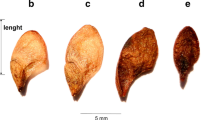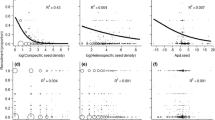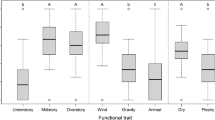Abstract
In order to assess the importance of seed dispersal (escape and colonization hypotheses), I used transplant experiments for seeds and seedlings of 5–11 plant species with fleshy fruits in a lowland tropical forest (Tinigua National Park, Colombia). I controlled seed density, distance to parental tree, and habitat type. I monitored seed removal, seedling survival, and seedling growth during the first year of development for an average of 554 seeds and 169 seedlings for each species. I supplemented the experimental results with measurements of natural recruitment. I found little support for the escape hypothesis during the seed and seedling stages. For six species that showed differences in seed removal associated with distance, five showed highest removal away from, than close to parent trees, suggesting predator satiation. Seedling survival during the first year was not consistently associated with low densities and long distances from parent trees. For the majority of species, seedlings did not survive flooding in low basins, and there was growth advantage for most plant species in canopy gaps. These differences imply advantages for seed dispersal to adequate habitats, as predicted by the colonization hypothesis. In contrast to experiments, strong negative distance-dependent effects were evident when analyzing natural recruitment patterns. The ratio between saplings and seedlings was higher away from parent trees for the species with enough recruitment to be analyzed and this suggests that a negative distance-dependent effect may also occur after seedling establishment. This pattern is suspected for several other species, but an analysis with some of the other most common trees showed a variety of negative, neutral, and positive distance dependent effects. This study emphasizes the importance of long-term studies to asses the role of seed dispersal.


Similar content being viewed by others
References
Andresen E (2002) Dung beetles in a Central Amazonian rainforest and their ecological role as secondary seed dispersers. Ecol Entomol 27:257–270
Augspurger CK (1983) Offspring recruitment around tropical trees: changes in cohort distance with time. Oikos 40:189–196
Augspurger CK (1984) Seedling survival among tropical tree species: interactions of dispersal distance, light-gaps, and pathogens. Ecology 65:1705–1712
Chauvet S, Feer F, Forget PM (2004) Seed fate of two Sapotaceae species in a Guianan rain forest in the context of escape and satiation hypotheses. J Trop Ecol 20:1–9
Cintra R (1997) Leaf litter effects on seed and seedling predation of the palm Astrocaryum murumuru and the legume tree Dipteryx micrantha in Amazonian forest. J Trop Ecol 13:709–725
Clark DB, Clark DA (1984) Spacing dynamics of a tropical rainforest tree, evaluation of the Janzen–Connell model. Am Nat 124:769–788
Connell JH (1971) On the role of natural enemies in preventing competitive exclusion in some marine animals and in rain forest trees. In: den Boer PJ, Gradwell GR (eds) Dynamics of populations. Center for Agricultural Publication and Documentation, Wageningen, pp 298–312
Curran LM, Webb CO (2000) Experimental tests of the spatiotemporal scale of seed predation in mast-fruiting Dipterocarpaceae. Ecol Monogr 70:129–148
DeStevens D, Putz FE (1984) Impact of mammals on early recruitment of a tropical canopy tree, Dipteryx panamensis, in Panama. Oikos 43:207–216
Forget PM, Milleron T, Feer F (1998) Patterns in post-dispersal seed removal by Neotropical rodents and seed fate in relation to seed size. In: Newbery DM, Prins HHT, Brown ND (eds) Dynamics of tropical communities. Blackwell Science Ltd., Oxford, UK, pp 25–49
Foster RB, Arce J, Wachter TS (1986) Dispersal and the sequential plant communities in Amazonian Peru floodplains. In: Estrada A, Fleming TH (eds) Frugivores and seed dispersal. Dr. W Junk Publishers, Dordrecht, pp 357–370
Gavin DG, Peart DR (1997) Spatial structure and regeneration of Tetramerista glabra in peat swamp rain forest in Indonesian Borneo. Plant Ecol 131:223–231
Harms KE, Wright SJ, Calderon O, Hernandez A, Herre EA (2000) Pervasive density-dependent recruitment enhances seedling diversity in a tropical forest. Nature 404:493–495
Houle G (1995) Seed dispersal and seedling recruitment—the missing link(s). Ecoscience 2:238–244
Howe HF, Smallwood J (1982) Ecology of seed dispersal. Ann Rev Ecol Syst 13:201–218
Hubbell SP, Ahumada JA, Condit R, Foster RB (2001) Local neighborhood effects on long-term survival of individual trees in a neotropical forest. Ecol Res 16:859–875
Hyatt LA, Rosenberg MS, Howard TG, Bole G, Fang W, Anastasia J, Brown K, Grella R, Hinman K, Kurdziel JP, Gurevitch J (2003) The distance dependence prediction of the Janzen–Connell hypothesis: a meta-analysis. Oikos 103:590–602
Janzen DH (1967) Synchronization of sexual reproduction of trees within the dry season in Costa Rica. Evolution 21:620–637
Janzen DH (1970) Herbivores and the number of tree species in tropical forests. Am Nat 104:501–528
Notman E, Gorchov DL (2001) Variation in post-dispersal seed predation in mature Peruvian lowland tropical forest and fallow agricultural sites. Biotropica 33:621–636
Ridley HN (1930) The dispersal of plants throughout the world. Reeve, Ashford
Russo SE (2005) Linking seed fate to natural dispersal patterns: factors affecting predation and scatter-hoarding of Virola calophylla seeds in Peru. J Trop Ecol 21:243–253
Russo SE, Augspurger CK (2004) Aggregated seed dispersal by spider monkeys limits recruitment to clumped patterns in Virola calophylla. Ecol Lett 7:1058–1067
SAS Institute (1994) JMP statistics and graphics guide. Version 3 of JMP SAS Institute Inc., Cary, North Carolina
Schupp EW (1990) Annual variation in seedfall, postdispersal predation, and recruitment of a neotropical tree. Ecology 71:504–515
Schupp EW, Fuentes M (1995) Spatial patterns of seed dispersal and the unification of plant-population ecology. Ecoscience 2:267–275
Shepherd VE, Chapman CA (1998) Dung beetles as secondary seed dispersers: impact on seed predation and germination. J Trop Ecol 14:199–215
Sokal RR, Rohlf FJ (1995) Biometry. WH Freeman and Company, New York
Stevenson PR (2000) Seed dispersal by woolly monkeys (Lagothrix lagothricha) at Tinigua National Park, Colombia: Dispersal distance, germination rates, and dispersal quantity. Am J Primatol 50:275–289
Stevenson PR (2002) Frugivory and seed dispersal by woolly monkey (Lagothrix lagothricha) at Tinigua National Park, Colombia. PhD dissertation, IDPAS-SUNY at Stony Brook, New York
Stevenson PR (2004) Phenological patterns of woody vegetation at Tinigua National Park, Colombia. Caldasia 26:125–150
Stevenson PR, Castellanos MC, Orrantia JC (1997) Dispersión diferencial de semillas de hobos (Spondias spp.) por micos churucos (Lagothrix lagothricha) y su relación con la morfología de los frutos. Universitas Scientiarum 4:135–144
Stevenson PR, Quiñones MJ, Ahumada JA (1998) Effects of fruit patch availability on feeding subgroup size and spacing patterns in four primate species at Tinigua National Park, Colombia. Int J Primatol 19:313–324
Stevenson PR, Quiñones MJ, Castellanos MC (2000) Guía de Frutos de los Bosques del Río Duda, La Macarena, Colombia. Asociación para La Defensa de La Macarena-IUCN, Bogotá
Stevenson PR, Castellanos MC, Pizarro JC, Garavito M (2002) Effects of seed dispersal by three ateline monkey species on seed germination at Tinigua National Park, Colombia. Int J Primatol 23:1187–1204
Stevenson PR, Suescún M, Quiñones MJ (2004) Characterization of forest types at the CIEM, Tinigua Park, Colombia. Field Stud. Fauna Flora La Macarena Colomb 14:1–20
Stevenson PR, Link A, Ramírez, B (2005) Frugivory and seed fate in Bursera inversa (Burseraceae) at Tinigua Park, Colombia: implications for primate conservation. Biotropica 37:431–438
Terborgh J, Pitman N, Silman M, Schichter H, Nunez P (2002) Maintenance of tree diversity in tropical forests. In: Levey DJ, Silva WR, Galetti M (eds) Seed dispersal and frugivory: ecology, evolution, and conservation. CABI Pub., New York, pp 1–17
van der Pijl (1972) Principles of seed dispersal in higher plants. Springer-Verlang, New York
van Schaik CP, Terborgh JW, Wright SJ (1993) The phenology of tropical forests—adaptive significance and consequences for primary consumers. Ann Rev Ecol Syst 24:353–377
Venable DL, Brown JS (1993) The population-dynamic functions of seed dispersal. Vegetatio 108:31–55
Wills C, Condit R (1999) Similar non-random processes maintain diversity in two tropical rainforests. Philos Trans R Soc Lond Ser B-Biol Sci 266:1445–1452
Wills C, Condit R, Foster RB, Hubbell SP (1997) Strong density- and diversity-related effects help to maintain tree species diversity in a neotropical forest. Proc Natl Acad Sci USA 94:1252–1257
Wright SJ, Carrasco C, Calderon O, Paton S (1999) The El Niño Southern Oscillation variable fruit production and famine in a tropical forest. Ecology 80:1632–1647
Wright JS (2002) Plant diversity in tropical forests: a review of mechanisms of species coexistence. Oecologia 130:1–14
Acknowledgements
I would like to thank all the field assistants who helped in gathering information, especially Alicia Medina, Carolina García, Monica Pineda, Tatiana Samper, Javier Cajiao, and Andrés Link. I thank Charles Janson, Patricia Wright, John G. Fleagle, Anthony DiFiore, Maria Clara Castellanos, Nicole Gibson, and several anonymous reviewers for their comments. This study was possible thanks to logistic support from Centro de Investigaciones Ecológicas La Macarena (CIEM) and the permits from Unidad de Parques Nacionales. Financial support came from the following institutions: La Fundación para la Promoción de la Investigación y la Tecnología (Banco de la República), Margot Marsh Foundation, Lincoln Park Zoo, Primate Conservation Inc., and IdeaWild.
Author information
Authors and Affiliations
Corresponding author
Rights and permissions
About this article
Cite this article
Stevenson, P.R. A test of the escape and colonization hypotheses for zoochorous tree species in a Western Amazonian forest. Plant Ecol 190, 245–258 (2007). https://doi.org/10.1007/s11258-006-9205-5
Received:
Accepted:
Published:
Issue Date:
DOI: https://doi.org/10.1007/s11258-006-9205-5




